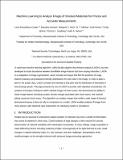| dc.contributor.author | Howard, Marylesa | |
| dc.contributor.author | Hock, Margaret C. | |
| dc.contributor.author | Meehan, B. T. | |
| dc.contributor.author | Ramos, Kyle J. | |
| dc.contributor.author | Bolme, Cindy A. | |
| dc.contributor.author | Sandberg, Richard L. | |
| dc.contributor.author | Dresselhaus-Cooper, Leora Eve | |
| dc.contributor.author | Nelson, Keith Adam | |
| dc.date.accessioned | 2018-02-01T13:59:53Z | |
| dc.date.available | 2018-02-01T13:59:53Z | |
| dc.date.issued | 2017-09 | |
| dc.date.submitted | 2017-04 | |
| dc.identifier.issn | 0021-8979 | |
| dc.identifier.issn | 1089-7550 | |
| dc.identifier.uri | http://hdl.handle.net/1721.1/113383 | |
| dc.description.abstract | A supervised machine learning algorithm, called locally adaptive discriminant analysis (LADA), has been developed to locate boundaries between identifiable image features that have varying intensities. LADA is an adaptation of image segmentation, which includes techniques that find the positions of image features (classes) using statistical intensity distributions for each class in the image. In order to place a pixel in the proper class, LADA considers the intensity at that pixel and the distribution of intensities in local (nearby) pixels. This paper presents the use of LADA to provide, with statistical uncertainties, the positions and shapes of features within ultrafast images of shock waves. We demonstrate the ability to locate image features including crystals, density changes associated with shock waves, and material jetting caused by shock waves. This algorithm can analyze images that exhibit a wide range of physical phenomena because it does not rely on comparison to a model. LADA enables analysis of images from shock physics with statistical rigor independent of underlying models or simulations. | en_US |
| dc.description.sponsorship | United States. Office of Naval Research (Grant N00014-16-1-2090) | en_US |
| dc.description.sponsorship | United States. Office of Naval Research (Grant N00014-15-1-2694) | en_US |
| dc.publisher | American Institute of Physics (AIP) | en_US |
| dc.relation.isversionof | http://dx.doi.org/10.1063/1.4998959 | en_US |
| dc.rights | Creative Commons Attribution-Noncommercial-Share Alike | en_US |
| dc.rights.uri | http://creativecommons.org/licenses/by-nc-sa/4.0/ | en_US |
| dc.source | arXiv | en_US |
| dc.title | Machine learning to analyze images of shocked materials for precise and accurate measurements | en_US |
| dc.type | Article | en_US |
| dc.identifier.citation | Dresselhaus-Cooper, Leora et al. “Machine Learning to Analyze Images of Shocked Materials for Precise and Accurate Measurements.” Journal of Applied Physics 122, 10 (September 2017): 104902 © 2017 Author(s) | en_US |
| dc.contributor.department | Massachusetts Institute of Technology. Institute for Soldier Nanotechnologies | en_US |
| dc.contributor.department | Massachusetts Institute of Technology. Department of Chemistry | en_US |
| dc.contributor.mitauthor | Dresselhaus-Cooper, Leora Eve | |
| dc.contributor.mitauthor | Nelson, Keith Adam | |
| dc.relation.journal | Journal of Applied Physics | en_US |
| dc.eprint.version | Author's final manuscript | en_US |
| dc.type.uri | http://purl.org/eprint/type/JournalArticle | en_US |
| eprint.status | http://purl.org/eprint/status/PeerReviewed | en_US |
| dc.date.updated | 2018-01-31T14:15:45Z | |
| dspace.orderedauthors | Dresselhaus-Cooper, Leora; Howard, Marylesa; Hock, Margaret C.; Meehan, B. T.; Ramos, Kyle J.; Bolme, Cindy A.; Sandberg, Richard L.; Nelson, Keith A. | en_US |
| dspace.embargo.terms | N | en_US |
| dc.identifier.orcid | https://orcid.org/0000-0002-0757-0159 | |
| dc.identifier.orcid | https://orcid.org/0000-0001-7804-5418 | |
| mit.license | OPEN_ACCESS_POLICY | en_US |
